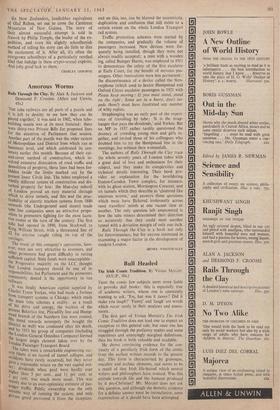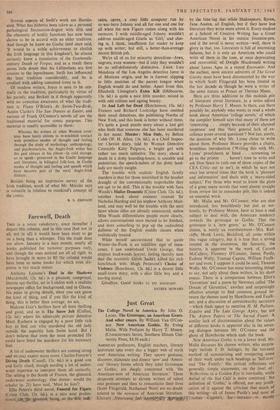Bull Headed
The Irish Comic Tradition. By Vivian Mercier. (O.U.P., 30s.) TIP" the comic few subjects seem more liable to provoke dull books: this is especially true of academic writers, whom one is constantly wanting to ask, 'Yes, but was it funny? Did it make you laugh?' Funny' and 'laugh' are words which occur rarely in their analyses and assess- ments.
The first part of Vivian Mercier's The Irish Comic Tradition does not lead one to expect an exception to this general rule, but once one has struggled through the prefatory matter and some repetitious and annoyingly marginal definitions, then his book is both valuable and readable.
He shows convincing evidence for the con- tinuity of a peculiarly Irish form of the comic from the earliest written records to the present day. This form is characterised by grotesque, macabre and archaic elements, and seems to be a result of that Irish life-hatred which several writers and philosophers have noticed. Was this attitude towards life and the humour produced by it pre-Christian? Mr. Mercier does not ask this question, and although the demotic evidence for a definite answer must be inconclusive, some examination of it should have been attempted. Several aspects of Swift's work are illumin- ated. What has hitherto been taken as a personal pathological fascination-disgust with filth and the obscenity of bodily functions has now been shown to be in accord with an older tradition. And though he knew no Gaelic (and once said, `It would be a noble achievement to abolish the Irish language in this kingdom'), he almost certainly knew a translation of the fourteenth- century Death of Fergus, and as a result there seems little doubt that his Lilliputians are first cousins to the leprechauns. Swift has influenced the later tradition considerably, and he is credited with adding sustained irony to it.
Of modern writers, Joyce is seen to be cen- trally in the tradition, particularly by virtue of his parody, and Beckett in it though apparently with no conscious awareness of what the tradi- tion is. Flann O'Brien's At Swim-Two-Birds, Austin Clarke's The Sun Dances at Easter, and various of Frank O'Connor's novels all use the traditional material for comic purposes. This material is readily accessible to them:
Whereas the writers of other Western coun- tries have lately striven to re-establish contact with primitive modes of thought and feeling through the study of mythology, anthropology, and psychoanalysis, the Anglo-Irish writer has the past always at his elbow—in cold storage, so to speak—preserved in the Gaelic language and literature, in bilingual folk-lore, in Gaelic modes of thought and feeling and speech which have become part of the rural Anglo-Irish dialects.
Besides being an impressive survey of the Irish tradition, much of what Mr. Mercier says is valuable in relation to mankind's concept of the comic.
B. S. JOHNSON



































 Previous page
Previous page